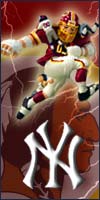Redskins coach prefers players with experience
This isn't the NFL that Joe Gibbs remembers. Nor is it the NFL he once dominated.
Gibbs carved out a Hall of Fame niche for himself as coach of the Washington Redskins in 1981-92, winning three Super Bowls. But that was a different era. It was before the salary cap. Before free agency. Before parity.
The philosophy of building a roster has changed. Old players are out; young players are in. When a player reaches his 30s, it's time for him to move on. Emmitt Smith, Joe Montana, Jerry Rice, Thurman Thomas, Bruce Smith, Warren Sapp, Eddie George -- some of the greatest names in the history of the NFL -- have been shoved out the door.
That's the philosophical hurdle Gibbs faces in his return. He has always embraced older players, which is understandable for a coach that has won 68 percent of his career games.
Older players are veterans, and veterans don't make the mistakes that younger players do. Mistakes cost you games. Gibbs' teams rarely beat themselves. He could always trust his experienced hands.
In 1982, when Gibbs won his first Super Bowl, his 45-man roster included 11 players in their 30s. Only four of them started, but two were marquee players: quarterback Joe Theismann, 32, and running back John Riggins, 33. Riggins was the Super Bowl MVP.
In 1987, when Gibbs won his second Super Bowl, he had fewer players in their 30s but more of them on the field. That season, he carried only eight 30-year-olds, but five were starters -- including quarterback Doug Williams, 32, who was the Super Bowl MVP.
In 1991, when Gibbs won his third Super Bowl, he was deep into his philosophy. Thirteen of his players were in their 30s, and seven of them were starters -- including wide receiver Art Monk, 33, and two of the Hogs, offensive linemen Joe Jacoby, 31, and Jeff Bostic, 32.
Now, zoom ahead to 2004. Gibbs inherited one of the NFL's youngest teams. Washington's 2003 roster averaged 26.3 years. Only seven players on the 53-man squad were in their 30s, and only three started. All those young legs produced a meager five wins and cost coach Steve Spurrier his job.
Gibbs immediately put his stamp on the Redskins in the off-season. He traded for quarterback Mark Brunell and signed defensive end Phillip Daniels, linebacker Michael Barrow and cornerback Walt Harris in free agency. All started last season, and all are in their 30s.
Gibbs brought in nine players in their 30s, and the Redskins went to training camp with 15 30-somethings. All figure to make the final 53-man roster, and as many as six could start.
``You need people who know how to play,'' said Theismann during a stopover at Redskins Park. ``That's what Joe's got now.''
The rub is that older players are more prone to injury. And when an older player gets hurt, it generally takes him longer to recover and return to the field.
Notice that Emmitt Smith missed more games in his first season with the Arizona Cardinals than in his combined 13 seasons with the Dallas Cowboys.
That's why teams release veterans rather than pay premium prices for their accomplishments. Dollars are too valuable under the salary cap for sentimentality, so descending talents with injury risks are liabilities.
If you play older players, you need a strong bench. Gibbs always had that when he didn't have to count his dollars. But the salary cap thins out that bench. The more you spend on aging starters, the less you can spend on backups.
Giving a 33-year-old quarterback an $8 million signing bonus and a 29-year-old cornerback (Shawn Springs) a $10 million signing bonus affects your team. It means more inexperienced and inexpensive players at the bottom of your roster. Mistakes loom there when those players hit the field.
If the Redskins stay healthy, they will see the Gibbs of old on the sideline. But if injuries become a problem, Gibbs will find the NFL a brand new ballgame.
http://www.ohio.com/mld/beaconjournal/s ... 525.htm?1c
